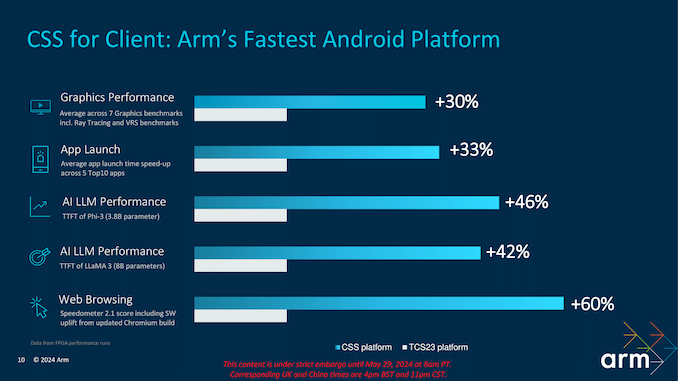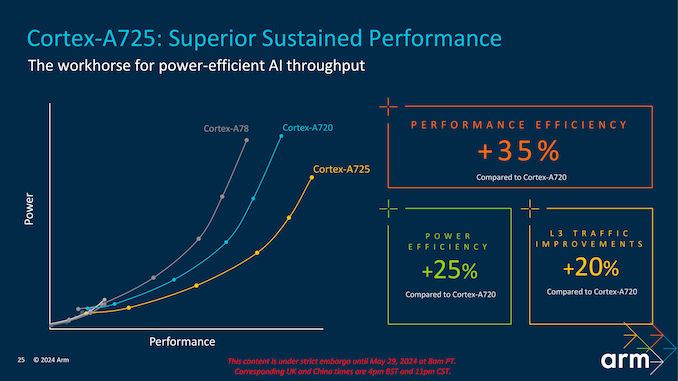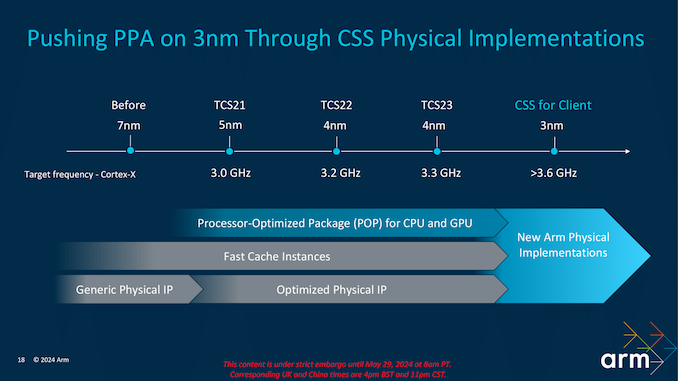Arm Unveils 2024 CPU Core Designs, Cortex X925, A725 and A520: Arm v9.2 Redefined For 3nm
by Gavin Bonshor on May 29, 2024 11:00 AM EST- Posted in
- CPUs
- Arm
- Smartphones
- Mobile
- SoCs
- Cortex
- 3nm
- Armv9.2
- Cortex-A520
- Cortex X925
- Cortex A725
Closing Remarks: Pushing Forward on 3 nm For 2024
Having attended Arm's Client Technology Day, my initial impressions were that Arm has opted to refine and hone its IP for 2024 instead of completely redefining and making groundbreaking changes. Following on from last year's introduction of the Armv9.2 family of cores, Arm has made some notable changes within the architecture of the latest Cortex series for 2024, with a clear and intended switch to the more advanced 3 nm process node, both with Samsung and TSMC 3 nm as the basis of client-based CSS for the 2024 platform.
The Cortex-X925, Cortex-A725, and Cortex-A520 cores have been optimized for the 3 nm process, delivering significantly touted performance and power efficiency improvements. The Cortex-X925, with its enhanced 10-wide decode and dispatch width and higher clock speeds reaching up to 3.8 GHz, looks to set a new standard for single-threaded IPC performance. Arm's updated v9.2 platform looks ideal for high-performance applications, including AI workloads and high-end gaming, both in the mobile space and with Microsoft's Windows on Arm ecosystem.
In the grand scheme of things, and from Arm's in-house performance comparisons between the new CSS platform and last year's TCS2023 version, Arm claims gains of between 30 and 60% in performance, depending on the task and workload. If it is to be believed and taken as gospel, the performance improvements are incredible, with the likely transition to 3 nm being the primary improver of performance rather than the underlying architectural improvements.
The Cortex-A725 balances performance and efficiency, making it suitable for several mid-range devices. Thanks to architectural enhancements such as increased cache sizes and expanded reorder buffers, Arm claims the improvements achieve up to 35% performance efficiency over the previous generation. The refreshed Cortex-A520 focuses primarily on being optimized on the 3 nm node while looking to remain unmatched in power efficiency, achieving a 15% energy saving compared to its predecessor. This core is optimized for low-intensity workloads, making it ideal for power-sensitive applications like IoT devices and lower-cost smartphones.
AI capabilities have been a significant focus in Arm's latest offerings. The Cortex-X925 and Cortex-A725 cores primarily integrate dedicated AI accelerators, allowing access to optimized software libraries, such as KleidiAI and KleidiCV, ensuring efficient AI processing. These enhancements are crucial for applications ranging from neural language models and LLMs.
Arm also continues to support its latest Core Cluster with a usually adept and comprehensive ecosystem driven by the new CSS platform, coupled with the Arm Performance Studio and in tandem with the Kleidi AI and CV libraries. These provided tools give developers a robust foundation to fully leverage the new architecture's capabilities. This effectively reduces the overall time-to-market and fosters innovations across various industries, such as content creation and on-device AI inferencing. The CSS platform's integration with operating systems such as Android, Linux, and Windows (Windows on Arm) ensures a larger reach in adoption. It pushes a wider level of development, making software and applications available on more devices than in previous generations.
In summary, Arm's move to all its latest CPU designs onto the 3 nm process technology and the refinements in the Cortex-X925 and Cortex-A725 cores demonstrate a strategic focus on optimizing existing architectures rather than making radical changes. These refinements include increased cache sizes per core, moving to a wider pipeline, and bolstering the DSU-120 Core Cluster for 2024, which certainly delivers substantial performance and power efficiency gains on paper.
While enabling new devices capable of handling demanding applications, most of these improvements in efficiency and performance are prevalent from the switch to the more advanced yet more challenging jump to the 3 nm node. As Arm continues to push the boundaries of what's possible with its IP, these technologies should pave the way for more powerful, efficient, and intelligent devices, shaping the future of what's possible and capable from a mobile device, whether that be in terms of the new generation of AI capable devices, or mobile gaming, Arm is looking to offer it all.













55 Comments
View All Comments
ET - Thursday, May 30, 2024 - link
I'm not sure why you're attributing this to insecurity and desperation when it's all about money. I can understand why end users would prefer companies to invest into things they feel are more relevant, but jumping on bandwagons (and driving them forward) is exactly the thing that companies wanting to keep their market healthy should do. ReplyGeoffreyA - Thursday, May 30, 2024 - link
Agreed; it is all about money. Generally, it is not to the benefit of the consumer or the world. An AI PC might be good for Jensen, Pat, Satya, Tim, Lisa, and co. but does not help most people. Replymode_13h - Thursday, May 30, 2024 - link
Ooh, you just got "named!"Seriously, your comment does indeed sound snarky and your reply sounds defensive and even a bit insecure. I don't think name99 was suggesting that you should want to be a genius, but rather pointing out that it pays to think beyond a single track.
> when one see Microsoft and Intel making an "AI PC," or AMD calling their
> CPU "Ryzen AI," and so on, it is little about true AI and more about money,
> checklists, and the bandwagon.
I'm reminded of when 3D-capable GPUs went so mainstream you could scarcely buy a PC without it. Yet, the killer app for the average PC user had yet to be invented. To some extent, the hardware needs to lead the way before mainstream apps can fully exploit the technology, because software companies aren't going to invest the time & effort in making features & functionality that only a tiny number of users can take advantage of.
Also, you say you want AI models to use little power, but progress happens incrementally and having hardware assist indeed improves the efficiency of inferencing on models that aren't all as big or demanding as LLMs. Reply
GeoffreyA - Thursday, May 30, 2024 - link
Fair enough. I apologise to everyone for negative connotations in my comment and replies, but the companies are free game and we ought to poke fun at them. I'm fed up, with the lies, marketing, double standards, doublespeak, and nonsense. These companies are only after money, and we are the fools at the end of the day. The last few years it was cloud; now, it's AI. What's next? ReplyGeoffreyA - Thursday, May 30, 2024 - link
As I've said, both here and in several comments elsewhere, AI and LLMs are of immense interest to me. I believe they're the Stone Age version of the stuff in our brains. What I'm trying to criticise is not LLMs or the technology, but the marketing ripoff that is bombarding us everywhere, this so-called AI PC, Copilot PC, or whatever Apple calls theirs. It's laughable the way they're plastering the term AI all over products. ReplySydneyBlue120d - Thursday, May 30, 2024 - link
Can we expect Samsung S25 3nm Exynos 2500 SOC to be based on this cores? Replyeastcoast_pete - Sunday, June 2, 2024 - link
After their rather poor showing with their Mongoose custom cores, I'd be very surprised if Samsung doesn't stick with ARM's designs for the CPU side of the Exynos 2500. What's (IMHO) really interesting right now is what Samsung will use for their GPU for the 2500. Rumors abound, many saying that they'll walk away from XDNA and use an in-house designed GPU, or come back to the ARM Mali mothership. The latter would put them in an awkward position, as Mediatek is likely the first out of the gate with their new 9400 featuring both the newest ARM cores and whatever the new version of Immortalis will be called. And Mediatek's Dimensity 9400 is (will be?) fabbed on TSMC's newest 3 nm node, so Samsung will want to have maximum differentiation here. ReplyJames5mith - Thursday, May 30, 2024 - link
"The enhanced AI capabilities ensure these applications run efficiently and effectively, delivering faster and more accurate results."ARM hardware will magically fix AI algorithms to be better than they otherwise would be? Really?!? Reply
mode_13h - Thursday, May 30, 2024 - link
They're probably referring to the fact that it can deliver good inferencing performance without having to resort to the sorts of extreme quantization behind some companies TOPS claims. Quantization often comes at the expense of accuracy, especially if it's done after training, rather than the model being designed and trained to utilize some amount of quantized weights. ReplyJames5mith - Thursday, May 30, 2024 - link
Also, amazing increases in performance per watt doesn't mean less power draw. If it draws 3x the power to do 4x the work, then it's increased efficiency 1.33x. But it's still drawing 3x the power. That means a battery will be drained 3x faster.Saying the 30w SoC does work more efficiently than the 10w SoC doesn't make it draw less power. Reply